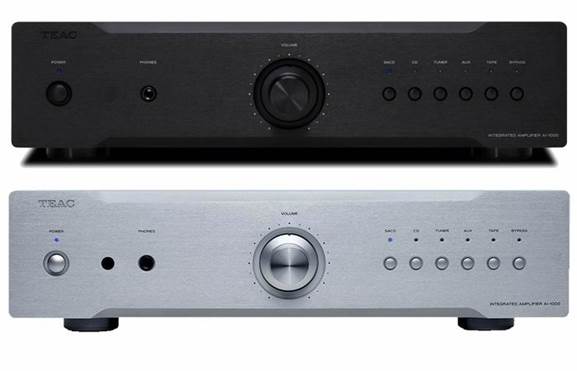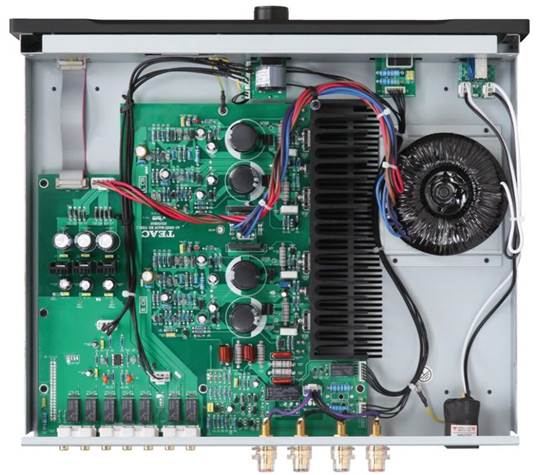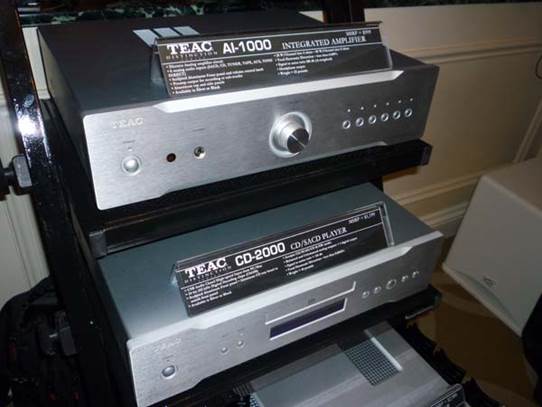Teac is back and this integrated offers a minimalist design
that has more than its fair share of charms
Teac has re-entered the two-channel market at this price
point after some time away and the AI-1000 is the smallest of three integrated
stereo amps in a new range with matching SACD players. Small is a relative term
and other than the burly Pioneer, this is the largest amp here. It is also the
simplest of all the models in terms of the specification. In a field of designs
with digital inputs and phonon stages, this is the only one to be fitted with
just line inputs. As the most expensive amp (along with the more lavishly
specified Pioneer), this is a bold move and hints at a different philosophy.

Teac AI-1000
Internally, the AI-1000 shows where some of the money has
gone. The 85W claimed power output design is a beautifully assembled amp inside
and out – with only the smaller Creek matching it for the quality of fit and
finish. Touches like the high-quality WBT speaker terminals and substantial
casework mean that the Teac looks the part and the controls – the volume knob
especially – all feel well weighted and impressively engineered. Although, the
lack of digital input might put some people off, the AI-1000 feels worth the
price. The remote is well laid out, attractive and easy to use.
Sound quality
The Teac very quickly shows some attributes that place it
right up at the top of the test, but then also reveals some infuriating areas
of performance that count against it. With Muse in particular, the AI-1000 is a
fine balance of drive, detail and control. The sound is big without tipping
over into being overblown and the detail and tonal accuracy is also extremely
compelling. It is able to match the NAD offering for sheer scale, but partners
this performance with a bass response that is deeper and more detailed than
most of the other amps here. The assurance it possesses with the Neil Cowley
Trio is also very impressive, although the piano takes on a slightly
harder-edged quality than it does with some of the other amplifiers tested.

This scale and
detail runs into some problems with Scratch Massive, as it is less sumptuously
produced than the first two pieces
This scale and detail runs into some problems with Scratch
Massive, as it is less sumptuously produced than the first two pieces. The
scale and confidence that the Teac displayed before remains, but the hard-edged
quality that showed in some parts of the Cowley recording are more apparent in
these less pristine circumstances and it can be ruthless with some parts of the
usually benign Aloe Blacc recording too, with a stridency to the backing piano
that isn’t really apparent with other amps in the test. It isn’t entirely fair
to call this ‘warts and all’ because the Creek in particular is able to match
the AI-1000 at its best and is entirely more forgiving of the other pieces. A
more minor criticism, but one still worth flagging up is that it rather lacks
the excitement and life that some of other integrated designs can bring to
their performances and doesn’t prove quite as engaging as other amps on test
here. In many ways, the Teac is a strong proposition and for well-recorded
material it has a scale and control that is among the best in the group. The
slightly merciless quality it shows with less benign material isn’t quite so
appealing, though, and the AI-1000 would need thoughtful system matching to be
a true all-rounder in the manner of some of the other amps in the test. When
you also take into account the fairly high price and limited features, the
AI-1000 is outpaced by some of the other amplifiers on test here.

The Teac is a
strong proposition and for well-recorded material it has a scale and control
that is among the best in the group
On test
One of the very important reasons why we independently test
all our Group Test components is that the manufacturer’s specifications are not
always comparable. Teac’s AI-1000, for example, might seem a lusty contender at
its rated 85/120W 8/4ohm but in practice, while beating its own spec at
103W/155W, it’s no more powerful than Rotel’s ‘60W’ RA-12 and even less speaker
load tolerant with its maximum current capped-out at 14A.Yet the AI-1000 is
still perfectly capable and offers a wide 89.5dB A-wtd S/N ratio (re. 0dBW), a
moderate 0.05ohm output impedance, sensibly band-limited response (–0.4dB/20kHz
to –4dB/100kHz) and distortion that varies from a low of 0.004% at 1kHz to
0.02% at 20kHz. Stereo separation is a little weak at HF (43dB/20kHz), but at
least the reduced +34dB gain is better suited to modern, high-output digital
sources.
Our verdict
·
Sound quality: 4/5
·
Value for money: 4/5
·
Build quality: 5/5
·
Features: 3/5
·
Like: Superb build; confident and bold sound with good recordings
·
Dislike: Less happy with ordinary material; limited spec
·
We say: Capable of excellent presentation, but performance is
rather inconsistent
·
Overall: 4/5
|
Details
·
Product: Teac AI-1000
·
Origin: Japan/China
·
Type: Integrated amplifier
·
Weight: 10kg
·
Dimensions (W x H x D) : 435 x 116 x 403mm
·
Features: Quoted power output: 85W RMS per channel into 8ohms;
Available finishes: black/silver; Line inputs: 6 RCA inputs; Digital inputs:
n/a
·
Distributor: Onkyo UK
|